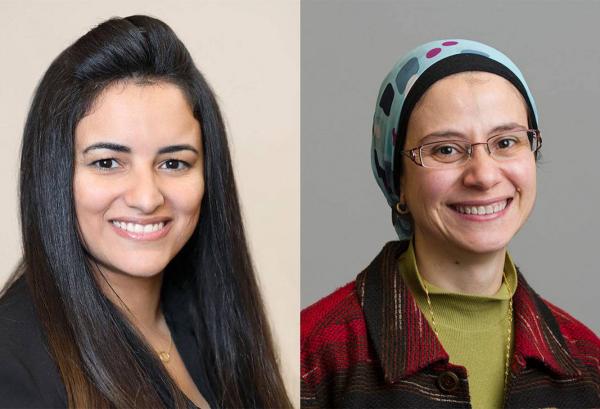Older Cells Make for Riskier Transplants
Examining Molecular Markers of Aging Could Improve Patient Outcomes

Measures of 'epigenetic aging' show that some people have cells that appear older than their actual age. A new IRP study finds support for selecting stem cell donors based on those age-related cellular markers.
In 2003, 92-year-old Fauja Singh ran the Toronto Waterfront Marathon in slightly under six hours, a feat that many people decades younger could not accomplish. Such examples reveal the problems with making assumptions about a person’s health based solely on age. Similarly, new IRP research suggests that assessing cellular characteristics associated with aging, rather than a person’s chronologic age in years, could improve outcomes for the more than 20,000 patients who receive bone marrow or blood stem cell transplants each year.1
Several diseases, including cancers such as leukemia, devastate the body’s supply of ‘hematopoietic’ stem cells, which develop into oxygen-carrying red blood cells, infection-fighting white blood cells, and blood-clotting platelets. Many of these patients are treated with a hematopoietic stem cell transplant (HSCT), which transfers stem cells from the blood or bone marrow of a healthy donor into the patient.
In order to reduce the odds of serious side effects or death after the procedure, patients ideally receive a transplant from a donor who is closely related to them, like a sibling. For the more than 70 percent of patients who receive an HSCT from an unrelated donor, studies have shown that receiving a transplant from a younger donor tends to improve outcomes. However, new research into ‘epigenetic aging’ has revealed that some people have cells with characteristics that are more akin to those typically seen in cells from people years or even decades older or younger.

Image credit: HiraV via Wikimedia Commons
Fauja Singh, who ran the Toronto Waterfront Marathon at age 92, is one of many examples of people whose age does not reflect their health characteristics.
“In the end, that’s what the patient is receiving: they’re receiving the donor’s cells,” says Rotana Alsaggaf, Ph.D., M.S., the new study’s first author and a postdoctoral fellow in the lab of IRP Stadtman Investigator Shahinaz Gadalla, Ph.D., M.B.Bch., the study’s senior author. “If we can find those cellular characteristics to really optimize donor selection and improve or expand the pool of donors, then that would be best for recipients.”
To test this idea, Dr. Gadalla, Dr. Alsaggaf, and their colleagues combed through data from the Center for International Blood and Marrow Transplant Research registry on 732 patients who received an HSCT from an unrelated donor to treat severe aplastic anemia, a condition that disrupts the body’s ability to make new blood cells. The IRP team used a tool, developed by researchers at the University of California at Los Angeles, to assess the ‘epigenetic age’ of donors’ cells by examining the pattern of chemical tags called methyl groups attached to various sites in their DNA. This pattern changes as people age, and there are some people in whom it more closely resembles the pattern typically seen in older or younger individuals.
As expected, the researchers found that donors’ age in years was highly correlated with the epigenetic age of their cells. Consequently, in most cases, a donor’s epigenetic age was equally useful as his or her actual chronologic age for predicting whether the patient who received that donor’s cells would pass away after the transplant. However, when donors’ cells had an epigenetic age 10 or more years greater than expected based on their chronologic age, the patients who received their cells were more than twice as likely to experience a potentially life-threatening transplant side effect known as chronic graft-vs-host disease (GVHD), which occurs when the immune cells that develop from the transplanted stem cells attack the recipient’s body.
“With donors who really have a big difference between their chronologic and epigenetic age, you see a clear relationship with worse outcomes for the patient,” Dr. Gadalla says. “This suggests that there is a group of donors who passed the screening — they were healthy enough for doctors to select them — but perhaps, if we had another marker of aging, they could have been excluded in favor of a different donor.”

Dr. Rotana Alsaggaf (left) and Dr. Shahinaz Gadalla (right)
In addition, the researchers found that the epigenetic age of the transplanted cells given to patients had increased significantly 100 days after the procedure, and the greater the extent of this cellular aging, the more likely a patient was to die after the transplant. The few patients whose transplanted cells showed an increase in epigenetic age of 15 years or more were five times as likely to die as patients with a smaller post-transplant increase in epigenetic age.
Dr. Gadalla and Dr. Alsaggaf are planning additional studies of epigenetic aging in other groups of patients treated with an HSCT, particularly older patients, since patients with severe aplastic anemia tend to be younger. Ultimately, they hope to combine their discoveries about epigenetic aging with other markers of cellular aging to improve selection of stem cell donors and post-transplant monitoring of cellular aging in patients after the procedure.
“We want to look at the combined effect of these markers,” Dr. Alsaggaf says. “They really are measuring different aspects of the cellular aging process, so we plan to look at those things together and how they interact in order to get a comprehensive picture of cellular aging.”
Subscribe to our weekly newsletter to stay up-to-date on the latest breakthroughs in the NIH Intramural Research Program.
References:
[1] Epigenetic Aging and Hematopoietic Cell Transplantation in Patients With Severe Aplastic Anemia. Alsaggaf R, Katta S, Wang T, Hicks BD, Zhu B, Spellman SR, Lee SJ, Horvath S, Gadalla SM. Transplant Cell Ther. 2021 Apr 1;27(4):313.e1-313.e8. doi: 10.1016/j.jtct.2021.01.013.
Related Blog Posts
This page was last updated on Tuesday, May 23, 2023
